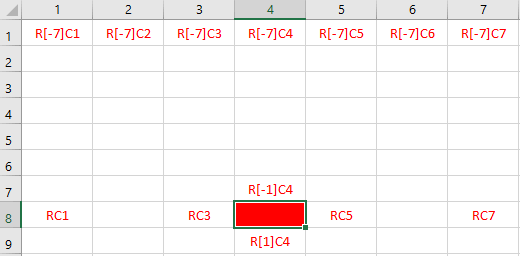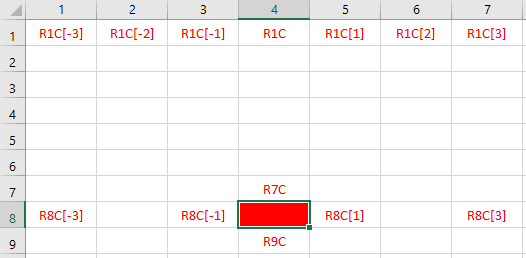- Switching
A1toR1C1 - Referring Cells using R1C1 Reference Style
R1C1Absolute ReferencesR1C1Relative ReferencesR1C1Mix ReferencesA1Vs.R1C1References
In Excel, you can refer to cells using two different styles: A1 and R1C1:
- The
A1style uses letters for columns and numbers for rows, such asA1,B2,C3, etc. - The
R1C1style uses numbers for both columns and rows, such asR1C1,R2C2,R3C3, etc. TheRstands for row and theCstands for column.

Switching A1 Reference to R1C1 Reference
To change to R1C1 reference style:
- Choose
File > Options - Click the
Formulasfrom the Options dialog box - Check the
R1C1 reference styleoption.

Referring to Cells with R1C1 Reference Style
In R1C1, when you refer to a cell it creates the address of referred cell using its distance from the active cell. The R1C1 reference style can have relative, absolute, or mixed references. Try the following examples by typing the described notations in the Name Box:

RCrefers to the same row and column number as where the cell itself is located, when you typeRCin Name Box, Excel will not move the active cell to a different location. Instead, it will keep the same cell selected.RC1refers to the same row and column 1. If your active cell isR5C4, typingRC1in the Name Box will move the active cell toR5C1.R1Crefers to the same column and row 1. TypingR1Cin the Name Box will move the active cell to the first row on the same column.R1C1refers to a cell in row 1 and column 1 (absolute reference, which is$A$1for A1 reference)R[-1]C[1]refers to 1 row up and 1 column to the right of where the active cell is located (relative reference).R[1]C[-1]refers to 1 row down and 1 column to the left of where the active cell is located (relative reference).
R1C1 Absolute References

A1 reference style uses dollar sign $ for absolute cell references. The R1C1 reference style doesn’t use any special character for the absolute references. The R8C4 is an absolute reference which refers to a cell located on row 8 column 4 (for A1 style reference it would be $D$8). R1C2 refers to a cell located row 1 and column 2 and so on.
R1C1 Relative References
Excel uses brackets [ ] to make a R1C1 relative reference and the number inside the brackets tell us the location of referenced cell from the active cell. For example:

RCIts points to the active cell itself.RC[1]TheRwithout brackets indicate that the referenced cell and active cell are on the same row.C[1]indicates that the referenced cell is on the next 1st column (to the right) from the current cell.R[1]CTheR[1]indicates the referenced cell is on the next 1st row (down) from the current cell. TheCwithout brackets mean the referenced cell and current cell are in the same column.R[1]C[1]Next row and next column from the current cell.R[-1]C[-1]R[-1]points to the previous row (upwards) andC[-1]means the previous column (to the left) from the current cell.
R1C1 Mix References

A mix-referenced cell uses a “relative row and absolute column” or a “relative column and absolute row” reference. For example, if the active cell R8C4, the mixed reference to R1C1 would be R[-7]C1 (relative row) or R1C[-3] (relative column).

Comparing A1 and R1C1 References
- The A1 reference style is the default one and uses letters for columns and numbers for rows.
- The R1C1 reference style uses numbers for both columns and rows and indicates the relative position of a cell from the active cell.
- R1C1 reference can be useful when you want to create formulas that use relative references.
- The A1 reference style is more intuitive and easier to use for most users.
The following table shows some examples to demonstrate a few basic differences between A1 and R1C1 references:
| A1 Reference Style | R1C1 Reference Style | Reference Type |
|---|---|---|
| A1 | R[-3]C[-2] | Relative |
| $A$1 | R1C1 | Absolute |
| $A1 | R[-3]C1 | Absolute column and relative row |
| A$1 | R1C[-2] | Absolute row and relative column |
C4 (or R4C3